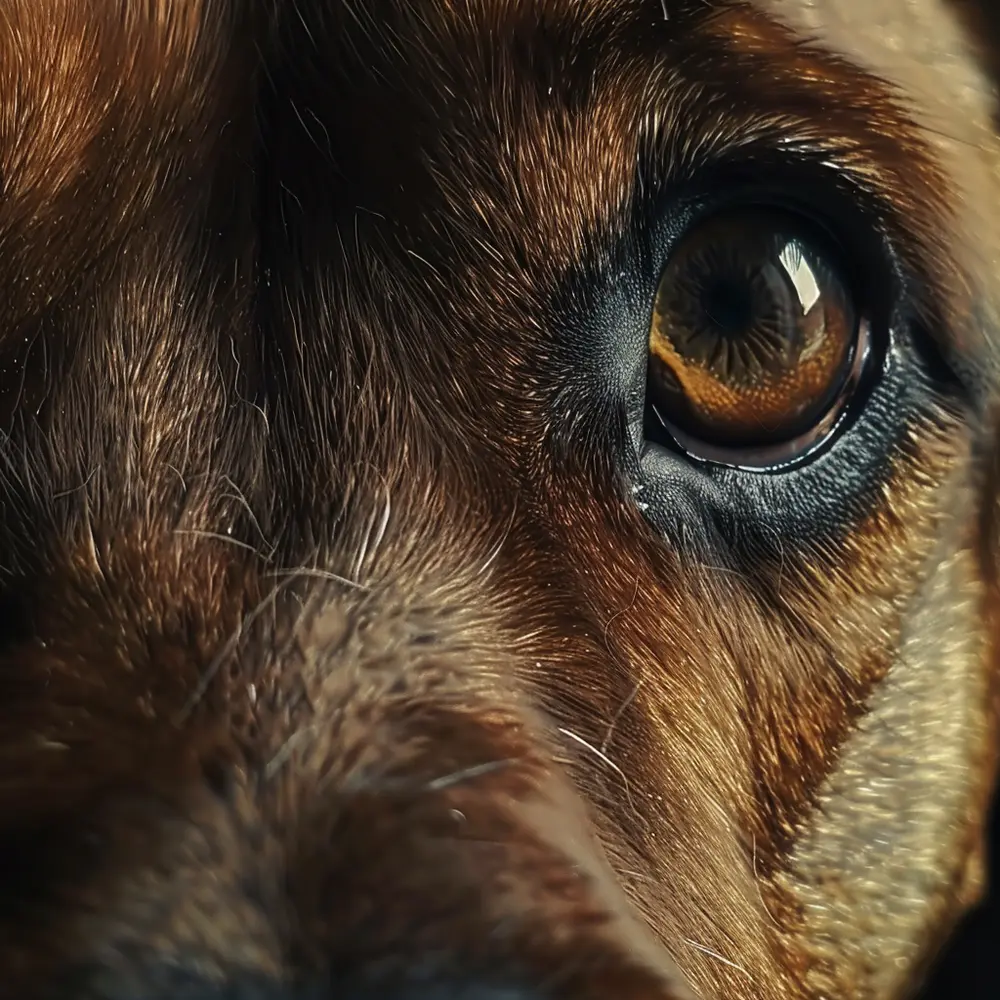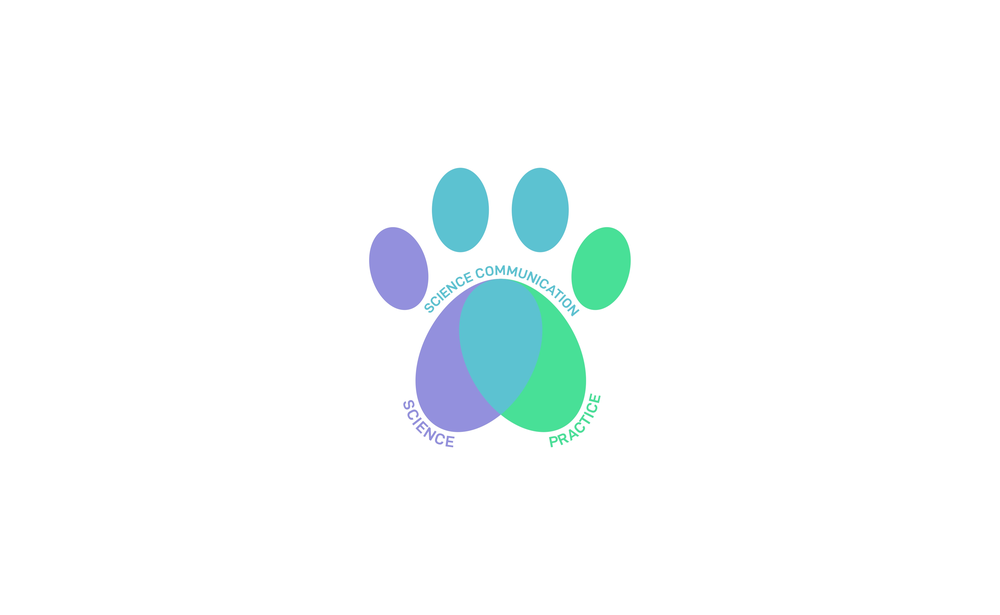Table of Contents:
Understanding Canine Vision: The Basics
Vision is a complex sense that differs significantly across species. To truly comprehend our dogs' perspectives, we must start with the fundamentals of canine vision. It provides an essential window into their behaviour and needs. Unlike humans, who generally rely heavily on their visual capabilities, dogs have evolved as scent-oriented creatures, which influences their sensory priorities. However, that does not mean sight is irrelevant to dogs; it plays a different role in their perception of the world.
When discussing the basics, we first look at the distinct structure of a dog's eye. A key feature is the tapetum lucidum, a layer of tissue behind the retina that enhances low-light visibility, causing the characteristic reflective glow in the dark. This adaptation indicates the importance of vision in dim lighting, a common condition for ancestral hunting scenarios. Another notable aspect is the presence of differing types of photoreceptor cells within their retinas. Dogs predominantly possess rod cells enabling them to detect movement and navigate effectively in low light, while the presence of cone cells allows for limited color perception.
Dogs have a broader visual field than humans because their eyes are positioned more laterally on their heads. This adaptation gives them a panoramic view, allowing for better detection of potential threats or prey. Yet, this comes at the expense of binocular vision and, consequently, depth perception, which is not as developed as in humans.
Understanding these physiological characteristics provides insights into how dogs perceive their surroundings. Recognizing that their visual perception is adapted to their ancestral needs helps us to tailor our interactions and care to suit their view of the world. Ensuring we consider their visual perception in our day-to-day lives together can make for a much richer and more rewarding relationship.
The Anatomy of a Dog's Eye
Delving deeper into the anatomy of a dog's eye allows us to appreciate the ingenious adaptations that cater to a dog's specific visual needs. At first glance, the eye structure bears similarities to the human eye but with several key variations that influence their visual perception.
The cornea, the outermost layer of the eye, is more pronounced in dogs, contributing to their wider field of view. It is transparent and curved, focusing light as it enters the eye. Just behind the cornea lies the aqueous humour, a fluid that maintains ocular pressure and nourishes the eye. The lens then further adjusts the focus, allowing dogs to see objects at various distances. This lens is more rigid in canines, which affects the degree of their focus flexibility, particularly in discerning fine details.
The iris functions as the gatekeeper of light, as in humans, with its opening, the pupil, controlling the amount of light that reaches the inner eye based on ambient lighting conditions. Unique to each breed, the shape of the pupils can range from round to more of a slit, affecting the light entry.
As the light passes through these components, it finally reaches the retina, a multi-layered tissue laden with photoreceptors that translates light into neural signals. The retina houses both the rod and cone cells; the ratio between these two types is what chiefly determines the dog's capacity for light sensitivity and colour detection. As a result, while dogs excel in perceiving motion and night vision, they lack the human-like acumen for detailed, colour-rich images.
The signals captured by the retina are relayed via the optic nerve to the brain, where they are decoded into the rich tapestry of sights that a dog experiences. This highly efficient and effective process supports a dog's ability to navigate its environment, an ability that plays a fundamental role in their daily lives and survival.
In essence, the anatomy of a dog's eye reflects the balance between their environmental requirements and evolutionary heritage. It is a sophisticated visual system tuned for survival that, while different from the human eye, is perfectly suited to a dog's way of life.
The Visual Capabilities and Limitations of Dogs
| Capabilities of Canine Vision | Considerations regarding Canine Vision |
|---|---|
| Dogs have good night vision, allowing them to see in low light conditions. | Dogs have dichromatic vision, meaning they see fewer colours than humans. |
| The canine visual field is wider than that of humans, offering greater peripheral vision. | They have less visual acuity, resulting in a less detailed vision compared to humans. |
| Dogs are better at detecting quick movements, important for hunting. | Their depth perception is not as advanced as in humans, particularly over long distances. |
| Their vision is highly attuned to picking up on subtle body language and cues. | Close-up vision is not as clear for dogs, as their eyes are optimised for detecting motion. |
Colour Perception in Dogs: More Than Black and White
The long-standing myth that dogs see the world in mere shades of black and white has been thoroughly debunked through scientific research. While it's true that a dog's colour perception is different from that of human beings, it is more accurate to describe their vision as similar to a person with red-green colour blindness, due to their dichromatic vision.
Dichromatic vision means that dogs mainly have two types of cone photoreceptors to detect colour, one that is sensitive to the blue-violet spectrum, and another that detects yellow light. This allows dogs to discern blues and yellows effectively, but reds and greens are likely to appear as greys or pale yellows. Consequently, a dog's world is indeed full of colour, but with a limited palette that excludes certain hues that are visible to the human eye.
This understanding has practical applications for dog owners. Choosing toys and accessories that are blue or yellow can make them more visually stimulating for dogs. Additionally, it is beneficial during training to use colour contrasts which a dog can easily distinguish, rather than relying on colours they might find difficult to separate from the background.
Thus, while not as rainbow-rich as our own, the canine colour spectrum is suited to their needs, allowing them to detect important visual cues in their environment. By accommodating your dog's specific visual capabilities, you can enhance their engagement and enjoyment in activities, which ultimately contributes to a happier and healthier life for your canine companion.
Field of View: How Dogs See the World Around Them
The field of view is the expanse of the surrounding environment that can be seen at any given moment without moving the eyes. For dogs, their field of view is significantly broader than that of humans, which has profound implications for how they interact with the world.
A dog's lateral placement of the eyes on the head enables a panoramic field of vision. This feature serves them well for detecting movement over a wide area, an ability that was undoubtedly advantageous for their wild ancestors. For a point of comparison, while humans have an average field of view of around 180 degrees, depending on breed, dogs can have a field of view ranging from 240 to 270 degrees. This allows them to monitor a large space effectively, making them excellent at picking up on peripheral movements that might go unnoticed by humans.
This enhanced field of view, however, comes with a trade-off. The area of binocular vision (where the fields of view of both eyes overlap) is narrower in dogs than in humans. While this dialed-down binocular perception impacts depth perception, it's crucial to note that dogs compensate for this through other senses and cues, ensuring their ability to judge distances remains intact during crucial activities like hunting or play.
Incorporating the knowledge of a dog's expansive field of view can be greatly beneficial. As caregivers, we can acknowledge that dogs catch sights and movements beyond our immediate notice, which may influence their behaviour or reactions in certain scenarios. Realizing this aspect of their perception can promote understanding and patience, enriching the bond we share with our furry companions.
Depth Perception and Motion Detection in Canines
Depth perception and motion detection are vital aspects of a dog's visual abilities, allowing them to gauge distance and identify moving objects, which are critical for everyday activities such as navigating their environment and hunting.
Although dogs have a wider field of view, their depth perception is somewhat compromised due to the reduced overlap of their binocular vision field. The binocular vision that does exist allows dogs to perceive depth, albeit not as precisely as humans. Nevertheless, they can still effectively measure distances, thanks in part to their excellent motion detection skills, which are a product of having a high concentration of rod cells in their retina.
The forte of canine visual perception lies in their remarkable ability to detect even the slightest movements, making them exceptionally sensitive to motion. This sensitivity is a throwback to their past as predators, where spotting and accurately judging the movement of prey was a matter of survival. Today, this translates into a dog's ability to play fetch with high proficiency, as they can readily follow the trajectory and speed of a moving object.
When it comes to looking after our dogs, understanding these visual strengths can assist us in tailoring activities and training methods. For instance, engaging in games that incorporate movement can satisfy a dog's inherent motion-tracking inclination and keep them mentally stimulated. Moreover, being mindful of their depth perception can prevent potential mishaps, particularly in unfamiliar environments.
In sum, recognizing the nuances of how dogs perceive depth and movement enriches our perspective of their experience and motivates practices that align with their natural abilities. Having this insight helps us better understand our dogs' behaviour and provide environments that suit their visual perception.
Comparing Canine and Human Visual Capabilities
To fully appreciate the distinctions between our furry companions and us, a direct comparison of canine and human visual capabilities sheds light on the evolutionary adaptations each species has undergone. While we share the fundamental aspects of visual anatomy, the specifics of our visual capabilities serve different purposes and reflect our diverse environmental interactions.
Humans are equipped with trichromatic vision, which allows us to enjoy a colourful and detailed view of our surroundings. This wide-ranging colour vision enables us to easily differentiate between a broad spectrum of colours, aiding in tasks that require fine discrimination.
In contrast, dogs excel in perceiving subtle movements and navigating low-light conditions. Their vision is attuned to picking up on the quick motions of small animals — an ability crucial for their ancestors' hunting lifestyle. Additionally, the presence of a larger number of rod cells and the tapetum lucidum gives dogs a superior sight during dusk, dawn, and in dimly lit environments, where human vision is less effective.
These differences underscore the importance of understanding our pets' perception — a critical step in fostering empathy and improving the way we care for them. By considering the strengths and limitations of a dog's sensory experience, we can create more enriching and supportive surroundings that cater to their natural instincts and capabilities.
Communication Through Sight: Visual Signals and Cues Between Dogs and Humans
Visual signals and cues play a significant role in the silent dialogue between dogs and humans. Understanding the nuances of this non-verbal communication enhances the synergy and bond between a pet and its owner.
For dogs, human body language and facial expressions serve as visual signals to interpret our intentions and emotions. They are highly attuned to our gestures and can learn to respond to specific signals with impressive accuracy. For instance, a simple hand motion can direct a dog to sit or stay, with many dogs being able to understand a range of such signals.
Similarly, dogs communicate their emotional state and intentions through their facial and body expressions. Subtle signs such as the direction of their gaze or the way they hold their ears can convey important information on their internal state, making it important for dog owners to become adept at interpreting these signals.
Paying attention to these visual signals and cues and responding appropriately can help prevent misunderstandings and conflicts, and facilitate a harmonious coexistence. It allows humans to be more responsive to a dog's needs and helps dogs feel more secure in their understanding of their human caregivers.
Building this level of communication requires patience, observation, and a willingness to learn from each other. For the most successful exchange, consistency in the visual signals and cues used by humans is key. Likewise, creating an environment where dogs feel at ease to express themselves visually leads to a more intuitive and fulfilling relationship.
The Impact of Visual Perception on Dog Behavior
The way dogs visually perceive the world has profound implications on their behaviour. Their vision is tailored to detect movement and navigate in varying levels of light, which, in turn, shapes their reactions and interactions within their environment.
For example, a dog's remarkable ability to notice the slightest motion can explain why a leaf fluttering to the ground or a small animal scurrying in the distance might instantly capture their attention and provoke a chase. This instinctual response ties back to their ancestral predatory traits and can impact how they play and exercise. It suggests why dogs might become fixated on moving objects and the reason they are often so enthusiastic about games that involve chasing, such as fetch or frisbee.
Moreover, a dog's perception of colour, although not as rich as humans, might influence which toys they find most engaging. Their attraction to blue and yellow objects can shape preferences and motivations, informing owners' choices in selecting products that can better catch a dog's eye and hold their interest.
Being mindful of these behavioural tendencies driven by visual perception can help us respond to our dogs' needs more effectively. For instance, ensuring that their living spaces have sufficient lighting can alleviate stress and fear during nighttime. It can also reinforce the significance of using visual signals in training and communication, maximizing their natural visual capabilities.
Enhancing Dog Training Through Visual Cues
Leveraging a dog's visual strengths can significantly enhance training techniques. Visual cues are an integral component of effective dog training and can be more impactful than verbal signals alone, especially when initially teaching a new behaviour.
Trainers can capitalize on a dog's sensitivity to movement by incorporating hand signals and gestures, which can be clearer for a dog to understand than spoken words. For instance, a pointed finger may be more effective in directing a dog's attention than simply saying "look."
Additionally, using items that stand out within a dog's dichromatic colour range — particularly those in shades of blue and yellow — can help in building association and memory. Coloured targets or markers can guide dogs during agility training or obedience exercises, making the process more fluid and comprehensible for them.
Understanding and applying these visual training aspects not only make the learning process more straightforward for dogs but also minimizes frustration for both the trainer and the canine. This considers the dog's natural perception and ensures a more rewarding and successful training experience.
Toys and Tools: Choosing the Right Visual Stimuli for Your Dog
Selecting the proper visual stimuli for your dog is crucial when it comes to toys and training tools. Effective stimuli not only capture your dog's attention but also enrich their playtime and learning experiences.
As dogs can perceive blue and yellow hues effectively, opting for toys in these colours can help them stand out against the varied shades of a dog's environment. This can be particularly beneficial in green spaces where red items might blend into the grass and foliage from a dog's perspective.
In addition to colour, the movement and size of objects are important factors to consider. Toys that are designed to mimic the erratic movements of prey, such as those that bounce unpredictably, can stimulate a dog's inherent predation instinct and encourage active engagement. However, it must be considered that these types of toys may also lead to high arousal levels.
Regarding training tools, utilizing markers or guide-posts in the dog's visual spectrum can assist in directing their movement and enhancing the clarity of the task at hand. This approach can streamline training sessions, making them more enjoyable and effective for both the dog and the trainer.
Overall, taking into account your dog's visual strengths when choosing toys and tools can lead to a more stimulating and satisfying interaction for your canine companion.
Conclusion: The Importance of Recognizing Dogs' Visual World
Recognizing the unique characteristics of a dog's visual world is not only fascinating—it's integral to providing them with the best care and understanding. As we've explored the many facets of canine sight, it’s clear that their vision is adapted to specific needs that are quite different from our own.
Our journey into the heart of canine vision has shown us that dogs perceive colours, detect motion, and navigate their surroundings in ways that are perfectly suited to their natural instincts. Respecting these abilities allows us to enhance our training, play, and companionship, fostering an environment where dogs can live comfortably and happily.
The knowledge we gain from studying canine vision can help us avoid potential conflicts, prevent accidents, and deepen the bond we share with our four-legged friends. It's a clear reminder of the mutual empathy and understanding required to coexist with another species.
In sum, acknowledging the visual perception of dogs enriches the shared experiences between humans and dogs, leading to a more harmonious and joyful life together. It's a testament to the bond that is possible when we take the time to see the world through their eyes.
FAQ: Insights Into Canine Visual Experience
What colors can dogs actually see?
Dogs have dichromatic vision, which means they see mainly two colors. They can perceive blue and yellow hues effectively, but reds and greens may appear grey or differently due to their limited color spectrum.
Do dogs see better at night than humans?
Yes, dogs have superior night vision compared to humans due to the presence of a larger number of rod cells in their retinas and a special reflective layer called the tapetum lucidum that enhances low-light visibility.
How does a dog's field of view compare to that of a human?
Dogs have a broader field of view than humans, ranging from 240 to 270 degrees, depending on breed, as opposed to the human field of view which averages around 180 degrees. This wider field helps them detect movement over a larger area.
Is it true that dogs have less visual acuity than humans?
Yes, dogs generally have less visual acuity, which means they don't see fine details as sharply as humans. Their focus is on movement and navigating in different lighting, rather than on clear static images.
Can understanding a dog's vision help in training them?
Certainly, knowledge of a dog's visual capabilities can enhance training by focusing on visual stimuli they can easily recognize, such as using blue and yellow colors, and incorporating movement to take advantage of their motion sensitivity.








